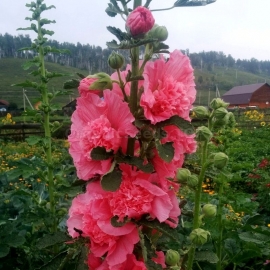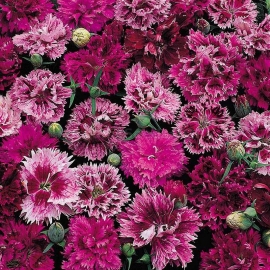




«Green stem» - Organic Castor Bean Seeds
1.14 €
An annual plant with large decorative leaves, strong stems, 140-200 cm high. Leaves are palmately dissected, up to 30 cm in diameter, green with a waxy coating.
-
Green Castor Bean / Ricinus communis
An annual plant up to 2-3 meters high, when grown in moderate shade or on weak soils (rolled lawn on sand), it can be of dwarf growth, i.e. no more than half a meter. Monotypic genus from the Euphorbiaceae family. The only species - Castor bean (Ricinus communis L.) - is an oilseed, medicinal and ornamental garden plant.
The stems are erect, branched, hollow inside, pink, red, purple or almost black, covered with a bluish wax coating.
The leaves are large, 30-80 cm long, deeply cut, sometimes separate, pointed, unequally serrated, dull green with petioles 20-60 cm long.
In summer, racemose terminal or axillary inflorescences of green flowers with a red tint appear. Castor oil is a monoecious plant: male and female flowers are located on the same plant; male in the upper, and female in the lower part of the axis of the inflorescence. The flowers are small, light cream or white. Stamens numerous, collected in branched bundles. Pistils with a tripartite style and fringed stigmas of red, crimson or light yellow.
The fruit is a spherical bare or prickly capsule up to 3 cm in diameter. Located between the leaves, the fruits give the plant a decorative look.
Mature seeds are oval in shape. They are convex on the dorsal side, flatter on the ventral side, and there is a longitudinal seam in the middle. The seed coat is smooth, shiny, variegated, mosaic. Depending on the castor bean variety, the mosaic can be brown, pink, light pink, contrasting against the background of the seed. The background color varies from gray to copper red. Thus, the seed with its shape and variegated color resembles a tick, hence the corresponding name of the plant. At the top of the seed there is a seedling, which easily falls off and looks like a white appendage.
Castor seeds contain 40 to 60% fatty oil. The seed nucleus contains up to 17% of proteins, including toxalbumin ricin, a highly toxic substance. Poisonous also contained in the same place in the amount of 0.1-1% ricinin - a pyridine alkaloid with a cyano group among the substituents.
Ingestion of the seeds of the plant causes enteritis, vomiting and colic.
Medical castor oil is the fraction obtained during the first hot pressing. To destroy the ricin, the oil is treated with hot steam. Ricin is a chemically unstable substance and decomposes as a result of hydrolysis.
This oil is a thick, viscous, pale yellow liquid with a characteristic odor. It contains up to 85% triglyceride ricinoleic acid. The rest of the triglycerides are oleic (9%), linoleic (3%) and various saturated acids (3%). Due to the presence of ricinoleic acid triglyceride, castor oil, unlike other vegetable fats, is soluble in 95% ethanol solution.
Castor oil is a classic laxative. It is part of some liniments, such as balsamic, which have antiseptic properties and the ability to accelerate tissue regeneration.
Technical grades of castor oil are used in various industries. Its high viscosity, which persists with increasing temperature, and relative inertness make this oil an exceptionally valuable lubricant for highly accelerated internal combustion engines (aviation, model), as well as a component of special lubricant mixtures.
Castor oil is cultivated mainly for its seeds (Semina Ricini vulgaris, Semina cataputiae majoris), from which castor (castor or ricin) oil (Oleum Ricini) is extracted.
Castor beans are cultivated in gardens as a fast growing ornamental plant. It is good on the lawn in a single planting or in groups (3-5 pieces) without other plants. In mixed groups does not give the desired effect. Castor oil can be used to decorate low walls.
The plant is sown in April in peat tablets, later transplanted into clay pots (1 l). At the end of the frost, they are planted in the ground without disturbing the earthen coma. Castor beans grow well in full sun and well-drained soils with regular watering
With this product buy
Product code: 12682
1.14 €
Perennial. Grown as a 2-year-old. Drought-resistant and frost-resistant plant with a height of 75-250 cm. The flowers are large, with a diameter of 10-15 cm, pink color. Used for decoration of flower beds, in groups and for cutting into large vases.
Product code: 12684
1.14 €
A spectacular plant with strong peduncles that do not require a garter, and luxurious lush inflorescences of a delicate lilac-lilac color, perfect for decorating flower beds and obtaining high-quality cut.
Product code: 12687
1.14 €
A plant with a height of 20 to 50 cm, flowering is long, the colors are very diverse, used for decorating flower beds, planting on balconies, for cutting, flowering occurs 60 - 80 days after germination.
Product code: 12691
1.14 €
Setaria viridis is a species of grass known by many common names, including green foxtail green bristlegrass, and wild foxtail millet. It is sometimes considered a subspecies of Setaria italica.




